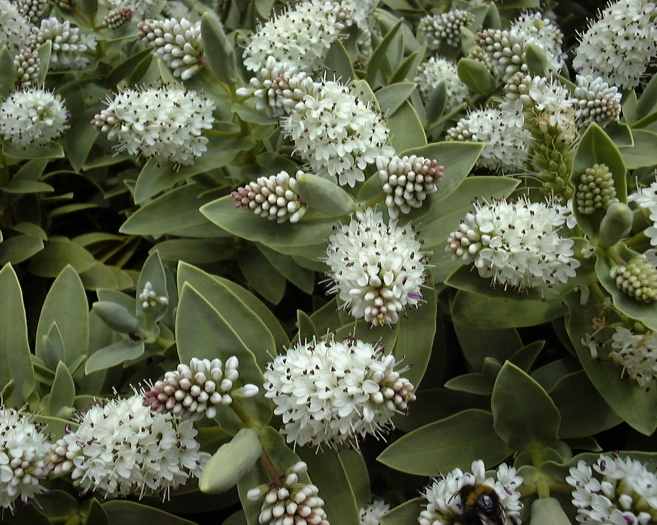White Hebe
(Veronica albicans)
White Hebe (Veronica albicans)
/
/

Alan Pascoe
CC BY-SA 3.0
Image By:
Alan Pascoe
Recorded By:
Copyright:
CC BY-SA 3.0
Copyright Notice:
Photo by: Alan Pascoe | License Type: CC BY-SA 3.0 | License URL: https://creativecommons.org/licenses/by-sa/3.0/at/deed.en | Uploader: Alan Pascoe | Publisher: Wikimedia Commons |













Estimated Native Range
Summary
Veronica albicans, commonly known as White Hebe, is an evergreen shrub native to the grasslands, alpine areas, and scrublands of New Zealand. It typically grows to a height and width of 2-3 feet (0.6-0.9 meters), forming a compact, bushy mound. The foliage is glossy and dark green, providing a lush backdrop for the flowers. White Hebe blooms profusely with spikes of white flowers that may have a hint of pink or purple at the base, appearing from late spring to fall, adding a long season of interest to the garden.
White Hebe is valued for its drought tolerance, low maintenance requirements, and the extended blooming period. It is often used in rock gardens, as a border plant, or in containers. This shrub thrives in full sun but can tolerate partial shade, and it prefers well-drained soil. While generally disease-resistant, it can be susceptible to root rot if overwatered. In regions with harsh winters, it may require protection or be grown as an annual.CC BY-SA 4.0
White Hebe is valued for its drought tolerance, low maintenance requirements, and the extended blooming period. It is often used in rock gardens, as a border plant, or in containers. This shrub thrives in full sun but can tolerate partial shade, and it prefers well-drained soil. While generally disease-resistant, it can be susceptible to root rot if overwatered. In regions with harsh winters, it may require protection or be grown as an annual.CC BY-SA 4.0
Plant Description
- Plant Type: Shrub
- Height: 1.5-3 feet
- Width: 1.5-3.2 feet
- Growth Rate: Moderate
- Flower Color: Pink, Purple, White
- Flowering Season: Spring, Summer, Fall
- Leaf Retention: Evergreen
Growth Requirements
- Sun: Full Sun
- Water: Low
- Drainage: Medium
Common Uses
Bank Stabilization, Bee Garden, Bird Garden, Border Plant, Butterfly Garden, Deer Resistant, Drought Tolerant, Groundcover, Hummingbird Garden, Low Maintenance, Potted Plant, Rabbit Resistant, Rock Garden, Salt Tolerant
Natural Habitat
Grasslands, alpine areas, and scrublands of New Zealand
Other Names
Common Names: Speedwell, Bird’s Eye
Scientific Names: , Veronica albicans, Hebe albicans, Hebe recurva, Veronica recurva,
GBIF Accepted Name: Veronica albicans Petrie